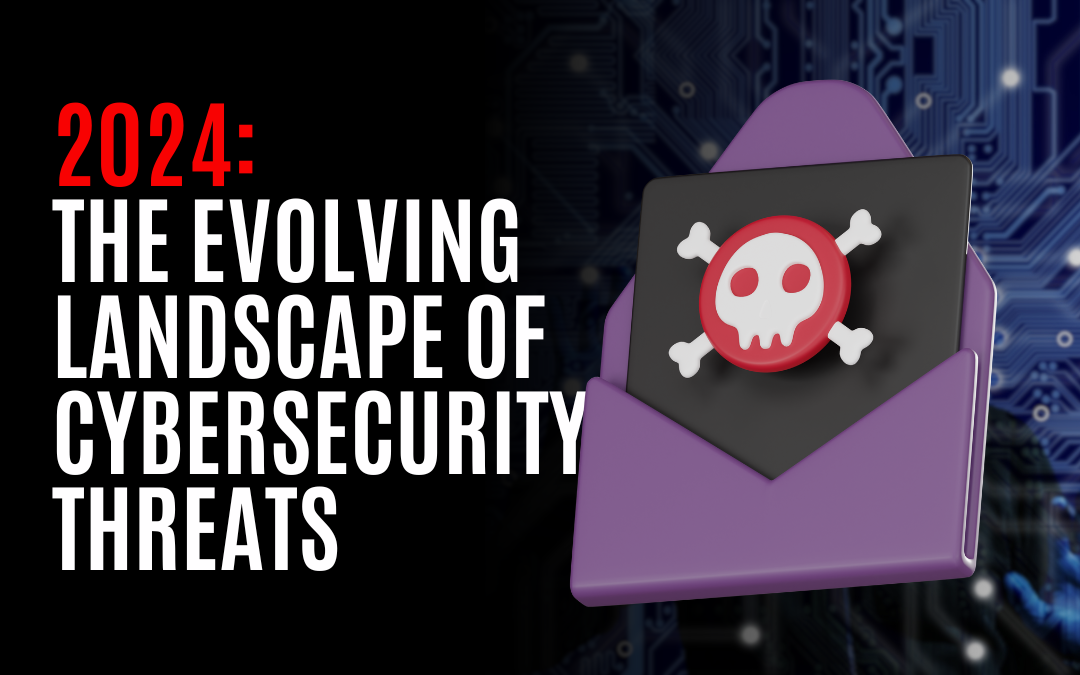Hey there, tech enthusiasts and cyber-sentries! Today, we’re diving deep into the swirling vortex of evolving cybersecurity threats. So, grab your digital armor and let’s decode the complexities of this ever-changing battlefield. 🛡️ 💻
The New Age of Ransomware: Strategic and Sinister
Gone are the days when ransomware was a scattergun approach. Today, it’s more like a sniper—precise, calculated, and chillingly effective. Imagine this: 80% of organizations have felt the sting of these attacks in just the past year. Cybercriminals are no longer casting wide nets; instead, they’re targeting high-value organizations, aiming for maximum impact and payout. It’s like choosing the biggest fish in the pond to ensure a hefty dinner.
AI: The Double-Edged Sword
The evolution of artificial intelligence (AI) has been a double-edged sword. On one hand, AI has been instrumental in driving innovation, optimizing processes, and solving complex problems across various sectors.🚀 On the other, it has given rise to a new breed of cyber threats, with cybercriminals leveraging AI to enhance the efficiency and efficacy of their attacks. This new paradigm has significant implications for cybersecurity, necessitating a reevaluation of defense mechanisms and strategies.🛡️
Automating Cyber Attacks with AI
Cybercriminals are using AI to automate attacks, making these incursions not only faster but also more sophisticated. The automation allows for rapid scanning of networks and systems for vulnerabilities, executing attacks at a scale and speed that would be impossible for human hackers. This includes everything from brute force attacks, where AI algorithms can quickly guess passwords, to more complex strategies like identifying and exploiting zero-day vulnerabilities. 🚨💻
Enhancing Phishing and Social Engineering
AI is also revolutionizing phishing attacks. Cybercriminals use machine learning to analyze vast amounts of data from social media and other sources to craft highly personalized and convincing phishing emails or messages. These messages are designed to trick individuals into revealing sensitive information or clicking on malicious links, with AI ensuring a higher success rate by tailoring the attack to the victim’s specific fears, interests, and behaviors.🎣🤖
Evading Detection
One of the most concerning aspects of AI-powered cyber attacks is their ability to evade detection.😨 Traditional security systems rely on recognizing patterns of known malware or attacks to protect against threats. However, AI can be used to create malware that constantly changes its code or behavior, making it much harder for these systems to identify and block the threat. Additionally, AI can analyze the defense mechanisms in place and develop strategies to circumnavigate them, staying one step ahead of cybersecurity efforts.🕵️♂️.
Implications for Cybersecurity
The use of AI in cyber attacks necessitates a significant shift in how cybersecurity is approached. Defensive AI technologies are being developed to counteract these threats, using machine learning to predict and identify attack patterns, and automate responses to incidents. However, this creates an arms race between cybercriminals and cybersecurity professionals, with both sides leveraging increasingly advanced AI to outmaneuver the other.🛡️💻
Ethical and Legal Considerations
The rise of AI in cybercrime also raises ethical and legal questions. The ability of AI to impersonate individuals, create deepfake videos, or conduct surveillance presents profound privacy concerns.😟 Furthermore, the international nature of cybercrime complicates legal efforts to combat these threats, as laws and regulations vary widely across jurisdictions.🌍
Phishing: Getting Personal
Phishing isn’t just about dodgy emails from a long-lost prince anymore. It’s evolved with a heavy dose of social engineering, making these attacks more personalized and deceptive. Imagine getting an email that looks like it’s from your boss, down to the last detail—scary, right?
The Bypass Of Our Armor: Supply Chain Attacks
Here’s where it gets even trickier. Our supply chains, the backbone of our business operations, are under siege. Last year alone saw a 50% increase in these attacks. It’s like finding out the bridge you’re driving on was built with compromised steel—nothing feels safe anymore. Regularly audit your supply chains’ posture.
Cryptocurrency: A Hacker’s New Playground
As digital currencies skyrocket in popularity, so do the associated risks. Last year, cryptocurrency thefts surged by a staggering 120%, totaling over $1 billion in losses. It’s a gold rush for cybercriminals, with digital wallets and exchanges as their new Wild West.
Protecting the Grid: A National Security Concern
With 60% of targeted attacks aimed at critical infrastructure, protecting these assets has transcended business—it’s now a matter of national security. Imagine cyber saboteurs targeting the very utilities that power our homes and businesses. It’s not just about money; it’s about stability. Some recent examples include: The Ukraine Power Grid Attack, Stuxnet, Colonial Pipeline, NotPetya, and Saudi Aramco.
Clouds Gathering: Security Must-Haves
The cloud might feel like it’s just up there, but its security holes can bring businesses right down to earth. With incidents up by 40% since last year, it’s clear: cloud security needs to be ironclad, treated with the same seriousness as locking our doors.🔒 As we increasingly rely on cloud services for storing sensitive data, running applications, and facilitating our day-to-day operations, the security of these cloud environments must be prioritized akin to the importance we place on securing our physical homes.🏠
IoT and Mobile: The Expanding Battlefields
Our world is more connected, yet more vulnerable. IoT device attacks have doubled, and mobile breaches have risen by 30%. Each connected device is a potential entry point for attackers—it’s like every window in your house having its own unique lock, but some are much easier to pick. People and businesses are increasingly attaching IoT devices such as smart thermostats, security cameras, wearable health monitors, and connected manufacturing equipment to their networks to enhance efficiency, monitoring, and automation.🔒🌐
The Human Factor: Training as a Shield
Despite all the tech at our disposal, humans remain the frontline defense—and often, the weakest link. Comprehensive and frequent cybersecurity awareness training isn’t just nice to have; it’s a must-have in fortifying this human shield.
The Road Ahead: Strategies and Solutions
Navigating this minefield of cyber threats requires a robust strategy. Here’s how I’m seeing the best-prepared organizations fortify their defenses:
– AI Defense: Leveraging AI not just for offense but as a critical part of defense mechanisms.
– Zero Trust Architecture: Adopting a trust-no-one approach within their networks to minimize damage from potential breaches.
– Enhanced Training: Investing heavily in training their workforce to recognize and respond to cyber threats effectively.
– Regulatory Compliance: Keeping pace with regulatory changes to ensure compliance isn’t just met but exceeded.
Checklist for Cyber Resilience:
- Audit Your Supply Chain: Regular checks can prevent a lot of headaches.
- Invest in AI Defense: Use AI to predict and respond to threats swiftly.
- Strengthen Phishing Defenses: Advanced filtering technologies and ongoing employee education are key.
- Secure Your Cryptocurrency: Use dedicated wallets and robust encryption.
- Adopt Zero Trust: Minimize risks within your network by trusting no one by default.
- Regular Training: Keep your team sharp and aware of the latest phishing scams and tactics.
As we wrap up today’s deep dive into cybersecurity trends, remember: staying informed is your first line of defense. Keep adapting, keep learning, and let’s ensure our digital worlds are fortified against these modern marauders. Stay safe out there! 🌐🔒


